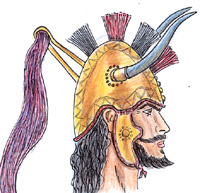 |
The Greek Age of Bronze
Iliad Helmets |
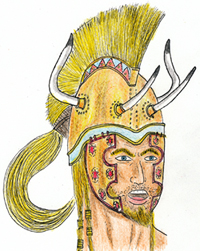 |
The Achaeans and Trojans helmets are mentioned in several verses of the Iliad and Odyssey (*1). Mostly of these helmets are not detailed described even if indications about the material, accessories, construction and peculiarity and generic characteristics are often given.
Homer used different words to describe the helmets, the words bellow mentioned are used interchangeably and are not specifically dedicated to the size or shape of a particular helmet. |
| In some cases dedicated epithets are used to identify specific characteristic of the helmets. |
| The different materials used for helmets construction are also well specified in several verses of the Homer's poems.
|
| Different words and adjectives are used to point out some generic characteristic of the helmets.
|
| Some of the components of the helmets are also well specified in several verses of the Homer's poems.
|
| For some helmets Homer also gives indications and descriptions of specific components or constructive characteristics.
|
There are no indications about the general shape and material of Agamemnon's helmet, indeed because the very high rank of the person the helmet can be logically immage well constructed more likely made of bronze with cheek guards. In the Iliad there is a detailed descripton of the various components and parts of the helmet decoration.
As for Iliad description Agamemnon set his helmet with four plumes (or tufts) and two crests (or tubes) and the horsehair atop it tossing, bristling terror. (Iliad XI 41-42) |
 |
| Based on the above elements the Agamemnon's helmet can be thus reasonably hypotized using various elements coming from archaeological evidences and Aegean figurative art. Because the Agamemnon's weaponry is from Cyprus (see also the page dedicate to the Iliad armour) the helmet general shape can be taken from one of the helmets of the warriors statue from Enkomi, in this case equipped with two typical late Achaean cheek guards as from the specimen from Tyrins. The two horns could have been similar to the lead specimens from Dendra and the separate four tufts can be based on some late Achaeans helmets representation from pottery. The atop horsehair and relevant support have been taken from the clay vessel from Bogazkoy showing a probable representation of an Ahhiyawa warrior. |
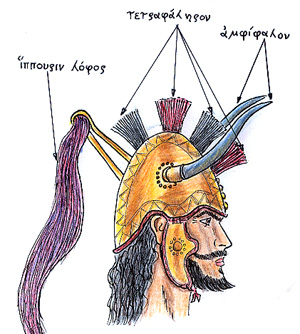 |
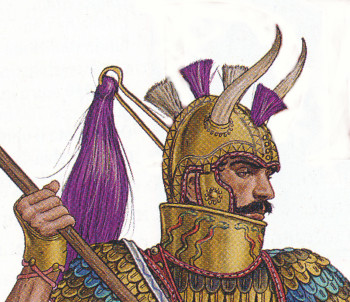 |
| The first Achilles helmet is the one worn by Patroclus during his fight against Hector. This helmet was made of bronze because its frontal part was shining (Iliad XVI 70-71) |
| This helmet was well manufactured and equipped with horsetail atop. (Iliad XVI 137-138) |
| The first Achilles' helmet is called "supplied with a tube or support for the plume/horsehair" or "with hollow eyed visor". In this case the first interpretation seems to be more reasonable because as said in the Iliad this helmet protect the Achilles' skull and the front, not the face (Iliad XVI 795-799) |
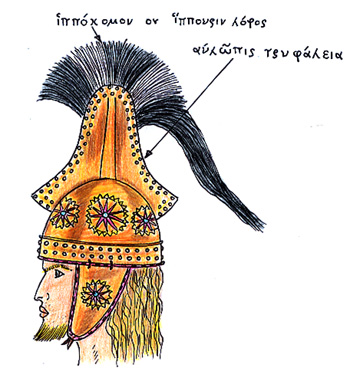 |
As hypotized by Peter Connolly and Raffaele D'Amato (*2) a reasonable interpretation of this kind of helmet brings back, for comparing archaeological and artistic sources, to a late bronze age middle-European helmet from Pass Lueg Austria. This specimen even if was found outside the Aegean area is fully reasonable for an Achaean warlord like Achilles coming from the north regions of Greek. In this case the helmet has been decorated with the same embossed red stars of the Achiles' first cuirass (see also the page dedicated to the Iliad armour) |
| Because of its tall upper tube a more Aegean/Anatolian variant of the first Achilles helmet can be hypotized using the type of bronze helmet attested in Cyprus. Also in this case the helmet has been modified with embossed red stars which seems to be an haraldic emblem of Achilles.
|
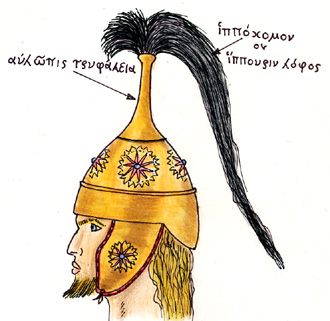 |
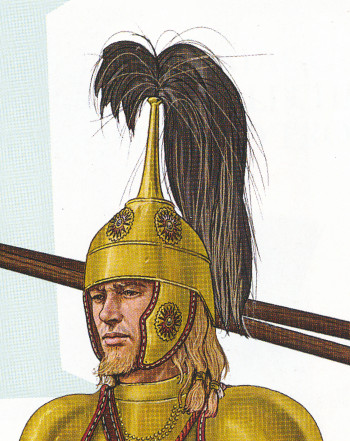 |
| The new splendid Helmet of Achilles was forged together the other weaponry by Hephaestus, God of craftsmen, through the intercession of the Achilles' mother Thetis. This helmet was sturdy and it fit the Achilles' s temples, beautiful, burnished work, and raised its golden plume (Iliad XVIII, 611-612) |
| Achilles lifts his massive helmet and he set it down on his head, and the horsehair plume shone like a star and the waving golden plume shook that Hephaestus drove in bristling thick along its ridge. (Iliad XIX, 380-383) |
| The Achilles's new helmet has four tubes or crests and, as already mentioned, a gilden mane. (Iliad XXII, 314-316) |
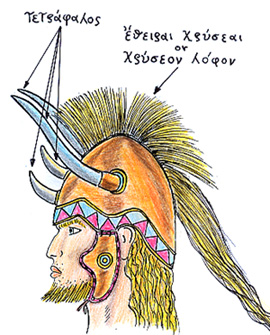 |
We can thus reasonably image the Achilles' new helmet like a typical late Achaean bronze helmet with cheek guards, equipped with four horns and a central highly voluminous and fluttering "gilden" horse-tail plume. Also in this case the helmets components have been arranged folowing some examples coming from Aegean art. The helmet has been also decorated accordingly to the Achiles' new panoply (see also the page dedicated to the Iliad armour) |
| Another reconstructive hypothes is also based on Peter Connolly and Raffaele D'Amato (*2) research modified with two additional lateral horns. This helmet can be considered a possible bronze variant of the helmets shown in the side A of the famous warriors vase from Mycenae. In this interpretation the four tubes have to be intended as the four horns. In the tall crest holder the voluminous and fluttering "gilden" horse-tail plume is placed. Also in this case the helmet has been decorated with embossed star motif accordingly to the Achiles new panoply.
|
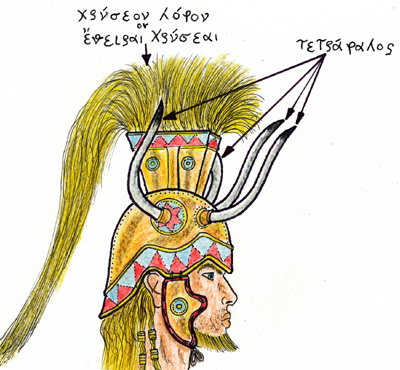 |
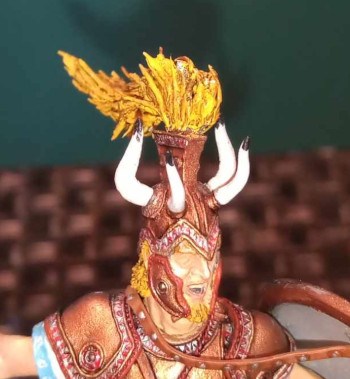 |
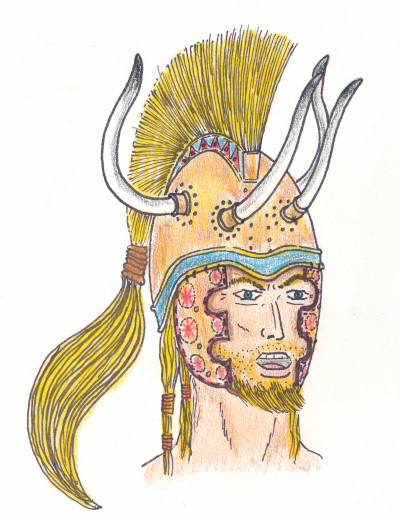 |
A reconstructive hypothesis can also be made using the two bronze cheek guards found in the grave 40 in Kalorisiki Cyprus previously wrongly interpreted as shield's decorative elements. The helmet general shape is also based on the one represented on a statue from Enkomi Cyprus. As for Iliad description the helmet has been represented with four horns or tubes and a central highly voluminous and fluttering "gilden" horse-tail plume.
|
An interesting representation of the Achilles' helmet has been made by Eric Shanower in number 27 of his awesome mithologically and archaeologically based comic serie AGE OF BRONZE THE STORY OF THE TROJAN WAR. This archaeologically reasonable late Achaean helmet shows all of the features of the Achilles' helmets as described in the Iliad:
A shining massive helmet decorated with four tubes or crests, supplied with a support for the plume/horsehair and it fit the Achilles' temples. |
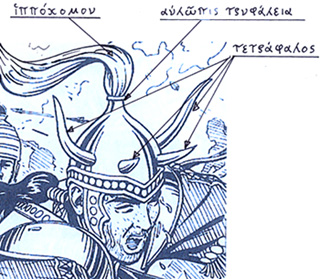 |
| ODYSSEUS: In the Iliad Odysseus worn, at least in one specific occasion, a boar tusks helmet because Meriones gave to him bow quiver and sword and over his head he set a helmet made of leather. Inside it was crisscrossed taut with many thongs, outside the gleaming teeth of a white-tusked boar ran round in rows stitched neat and light a master craftman's work, the cap in its center padded soft with felt (Iliad X, 260-265) |
| In the Odyssey Odysseus referring to himself talk about a bronze helmet fitting his temples,(Odyssey XVIII, 378) |
| Odysseus, his son Telemachus and the two servants were also wearing bronze helmets with horse tail while their were fighting against the suitors. (Odyssey XXII, 111) |
| AJAX: his helmet is also more likely made of bronze with cheek guards because: -a terrific din at his temples, his shining helmet clashing under repeated blows, relentless blows beating its forged plates. (Iliad XVI, 104-106) |
| ATHENA: The gilded helmet of Athena could be similar to the one of Agamemnon being also this helmet equipped with two tubes and four plumes. (Iliad V, 743-744) |
| DIOMEDES: His helmet is also called "supplied with a tube or support" or "with hollow eyed visor". In this case both the interpretations can be valid. (Il. V, 183) |
| During the night mission together Odysseus Thrasymedes gave to Diomedes a helmet bullí-hide, bare of ridge and crest, a skullcap, so itís called and made to protect the heads of tough young-blooded fighters (Iliad X, 257-259). |
HECTOR: His helmet is very often described as shining so it was for sure made of bronze.
(Iliad II, 816; III, 83/324; V, 689/680; VI, 116/263/342/359/369/440/520; VII, 158/233/263/287; VIII, 160/324/377; XI, 315; XVII, 96/122/169/188//693; XVIII, 21/131/284; XIX, 134; XX, 430; XXII, 232/349/337/355/471) |
| The Hector's helmet is described with the horsemane plume nodding on top of the helmet. (Iliad VI, 469-470) |
| The Hector's helmet is made of bronze with three layers and it is also called "supplied with a tube or support" or "with hollow eyed visor". This helmet was a gift of Apollo (Iliad XI, 351-353) |
| MENELAOS: His helmet is described made of bronze (Iliad X, 30-31) |
| The Menelaos's helmet is equipped with crest (or tube) and horsehair (Iliad XIII, 614) |
| In one occasion Menelaos wears a possible "tiara helmet" (Iliad X, 30) |
| PARIS (ALEXANDROS): His helmet is described well constructed with horse tail plume (Iliad III, 336-337) |
| Homer also describes the quilted throat strap of the Paris' helmet (Iliad III, 371-372) |
| NESTOR: His helmet is only described as shining so more likely made of bronze (Iliad X, 76) |
| AENEAS: His helmet is only described as solid or massive (Iliad XX, 162) |
| ASKALAPHOS: His helmet is also described as shining and it is called "supplied with a tube or support" or "with hollow eyed visor" (Iliad XIII, 527/530) |
| TEUKROS: He was also equipped with a well made helmet with horse hair plume (Iliad XV, 480-481) |
| DAMASOS: His helmet is described with bronze cheek guards (Iliad XII, 183) |
| DOLON: During his night mission he was wearing a weasel skin helmet (Iliad X, 335) |
| EXAMPLE OF REASONABLY SPECULATIVE HELMETS
|
In several movies, books and general pubblications the Achaeans or Trojans helmets are normaly represented in immaginative way or using rough and stereotyped reproduction of Greek later helmet used during the Greek Classical or Helenistic time. Sometimes a very strange mix of these elements is also used.
These drawings have to be intended as example of how immaginative helmets, but reasonably based on Achaean style helmets design and elements, can be hypothetically suggested. |
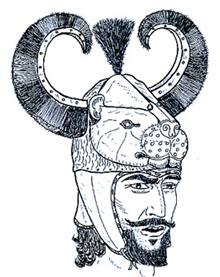 |
During the Greek Classical and Hellenist time some particular type of helmets reproducing animal-shaped head were sometime used. This reconstruction shows an hypothetical achaean high rank variant of these helmets made using a typical lion's gold head, cheek guards and crests/plume based on art representations of some early Achaean helmets. |
The gold lion's head is based on the famous gold rhyton in form of a lion's head from Shaft Grave IV in Mycenae. Animal-shaped rhytons were almost certainly used for cult purposes.
This element has been used for the hypothetical reconstruction taking into account that it was originaly interpreted by Schliemann as a part of an helmet.
|
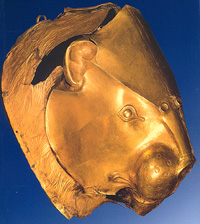 |
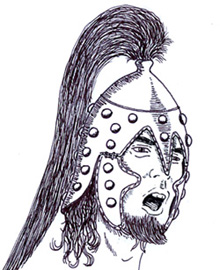 |
As shown in this page several helmets mentioned in the Ilaid are called "supplied with a tube or support" or "with hollow eyed visor". Even if some achaean hollow eyed helmets are also attested in the artistic fonts, a very suggestive helmet can be hypothetically represented using the specimen represented in the fresco from Pylos with additional large achaean style cheek guards and the upper horse hair crest. |
Another suggestive hollow eyed helmet can be hypothetically made using the low profile minoan and early Achaean helmet represented in some artistic fonts from Zakro Crete and Pylos.
Also in this case the helmet has been made more impressive with a boar tusk central horn and crest being these elements attested in some artistic representaion of Minoan and Achaean helmets.
|
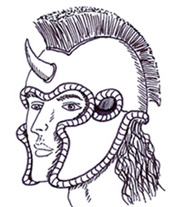 |
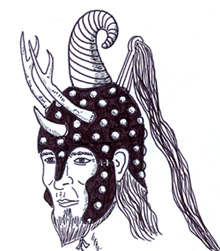 |
A non metallic speculative helmet can be made using several different elements from Achaean and Anatolian art. In this case the helmet general shape and metal disk reinforcements is basically based on the one represented in the side A of the warriors vase from Mycenae modified with two upper crest and the central boar tusk horn based on the Hittite representation of the possible Ahhiyawa warlord. From the two deer horns have some of the specimens found in several Achaean site have been used. Also in this case the helmet general design can be compared with some very schematic representation coming from Aegean art. |
(*1) A very complete and exaustive analysis of the homeric helmets compared with Iliad and Odyssey description is from JUERGEN BORCHHARDT Homerische Helme Verlag Philipp von Zabern, Mainz am Rhein 1972.
|
(*2)PETER CONNOLLY The leggend of Odysseus OXFORD UNIVERSITY PRESS 1986. And Metal figurine from SOLDIER Hector and Achilles Archaeological Research by RAFFAELE D'AMATO sculpture by ADRIANO LARUCCIA
|
|